Retail sale of other goods in specialized store accounts for majority of establishments
The final results of the 2013 Annual Survey of Philippine Business and Industry showed that a total of 99,614 establishments were engaged in wholesale and retail trade; repair of motor vehicles and motorcycles nationwide. More than ninety one percent or 91,144 establishments had a total employment (TE) of less than 20 and the remaining 8.5% or 8,470 were establishments with TE of 20 and over.
Retail sale of other goods in specialized stores had the highest number of establishments which accounted 30,550 or 30.7 percent of the total. This was followed by establishments engaged in retail sale of other household equipment in specialized store with 13,472 (13.5%). Establishments engaged in retail sale of food, beverages and tobacco in specialized stores came in third with 8,897 or 8.9 percent (Figure 1).
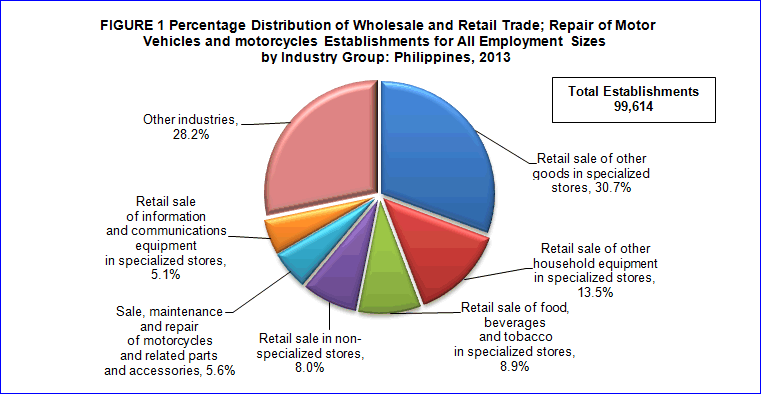
Retail sale of other goods in specialized stores hire the highest number of workers
In 2013, the estimated employment of the sector was 995,081 workers of which 963,634 (96.8%) were paid workers and the rest were working owners and unpaid workers. About 44 percent of the total employees worked for establishments with TE of 20 and over and the 56 percent remaining worked for establishments with TE of less than 20.
The top five retail establishments provided employment to more than half (63.7%) or 633,725 workers to the total labor force of the sector. These were the following:
- Retail sale of other goods in specialized stores with 215,106 (21.6%)
- Retail sale in non-specialized stores with 64,966 (16.6%)
- Retail sale of other household equipment in specialized, 120,168 (12.1%)
- Wholesale of households goods, 72,724 (7.3%)
- Wholesale of food, beverages and tobacco, 60,761 (6.1%)
The average number of workers per establishment of the sector was recorded at 10 employees. Sale of motor vehicles recorded the highest at 24 employees, followed by wholesale of food, beverages and tobacco at 22 employees. Retail sale in non-specialized stores came as third posting an average of 21 employees per establishment.
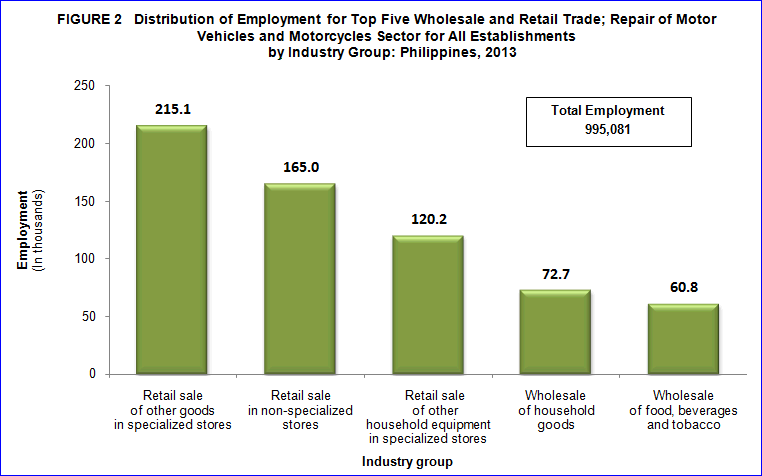
Total compensation reaches PHP137.0 billion
Total compensation paid by the sector to employees reached PHP137.0 billion in 2013, equivalent to an average annual compensation of PHP142.2 thousand per employee. For the establishment with total 20 and over, the total compensation reached PHP73.2 billion amounting to an average annual compensation of PHP168.6 thousand per paid employee. On the other hand, establishment with TE less than 20 paid only PHP63.7 billion or PHP120.5 thousand per paid employee.
By industry group, retail sale of other goods in specialized stores paid the highest compensation expenditures amounting to PHP28.5 billion or 20.8 percent of the total. Retail sale in non-specialized stores was second with PHP20.0 billion or 14.6 percent. Wholesale of household goods was also with PHP14.7 billion (10.7%). Non-specialized wholesale trade recorded the lowest payment at PHP127.7 million (0.1%).
Workers of wholesale of machinery, equipment and supplies are highest-paid employees in 2013
Workers in wholesale of machinery, equipment and supplies received the highest average annual compensation of PHP227.6 thousand or an average monthly compensation of PHP18,968. On the other hand, workers employed in maintenance and repair of motor vehicles received the lowest compensation of PHP87.8 thousand or monthly compensation of PHP7,319 (Figure 3).
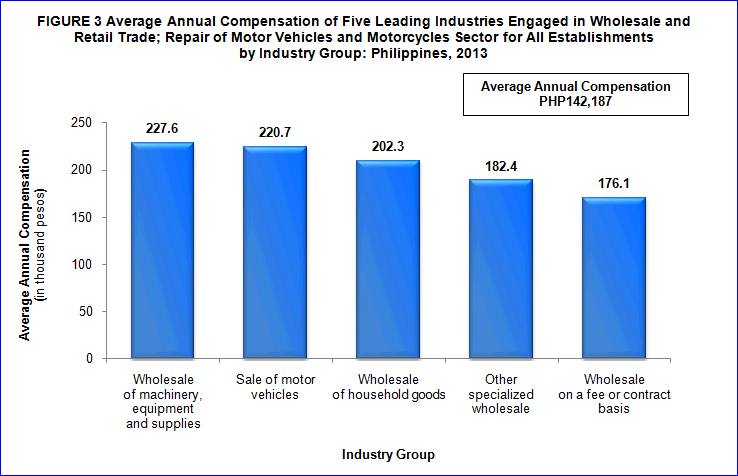
Retail sale in non-specialized stores contribute the largest share in income and expense
The total income generated by the sector amounted to PHP3.7 trillion and total expense incurred was valued at PHP3.5 trillion in 2013. Almost two-third of the total income as well as the total expense was contributed by establishments with TE of 20 and over.
Retail sale in non-specialized stores earned the highest income of PHP604.6 billion (16.5%), followed by retail sale of other goods in specialized stores with PHP523.7 billion (14.3%). Other specialized wholesale ranked third with PHP443.2 billion return (12.1%). While, non-specialized wholesale trade made the lowest earnings of PHP3.3 billion
Likewise, Retail sale in non-specialized stores had incurred the largest expenditures at PHP580.3 billion (16.5%). Retail sale of other goods in specialized stores and other specialized wholesale spent PHP508.4 billion (14.5%) and PHP425.8 billion (12.1%) overheads respectively. On the other hand, Non-specialized wholesale trade incurred the lowest expense of PHP3.2 billion. Figure 4 below shows the top five industry groups in terms of income and expense.
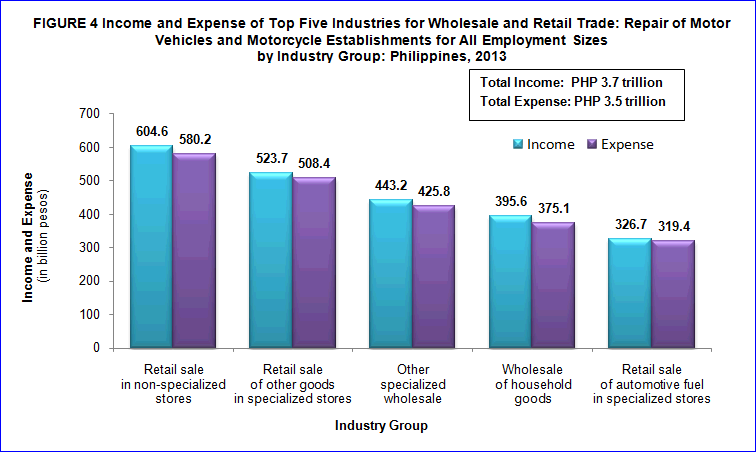
Income- expense ratio equivalent to 1.04
The income per peso expense generated an average proportion of 1.04 in 2013. Wholesale on a fee or contract basis exhibited the highest with 1.19. On the other hand, retail sale of automotive fuel in specialized stores recorded the lowest ratio of 1.02.
Gross margin reaches PHP569.9 billion
Gross margin (or trade margin) of the sector amounted to PHP569.9 billion output in 2013. Retail sale in non-specialized stores reached with PHP97.9 billion, (17.2%), Retail sale of other goods in specialized stores with PHP93.2 billion (16.4%), and wholesale of household goods with PHP82.2 billion (14.4%). Non-specialized wholesale trade produced the lowest output with only PHP396.1 million (0.1%).
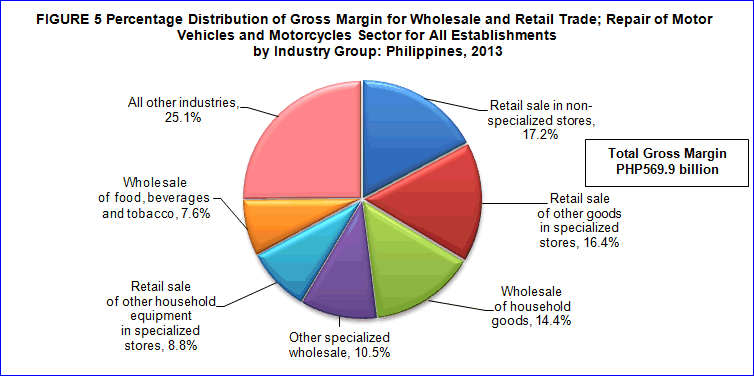
Value added amounts to PHP340.9 billion
Value added generated by wholesale and retail trade; repair of motor vehicles and motorcycles sector was estimated at PHP340.9 billion in 2013.
Top five industries produced more than half (62%) the total value added in 2013 of the sector. These were: retail sale in non-specialized stores with PHP53.8 billion (15.8%), retail sale of other goods in specialized stores with PHP50.8 billion (14.9%), wholesale of household goods with PHP43.0 billion (12.6%), other specialized wholesale with PHP33.5 billion (9.8%) and retail sale of other household equipment in specialized stores with PHP30.4) (8.9%).
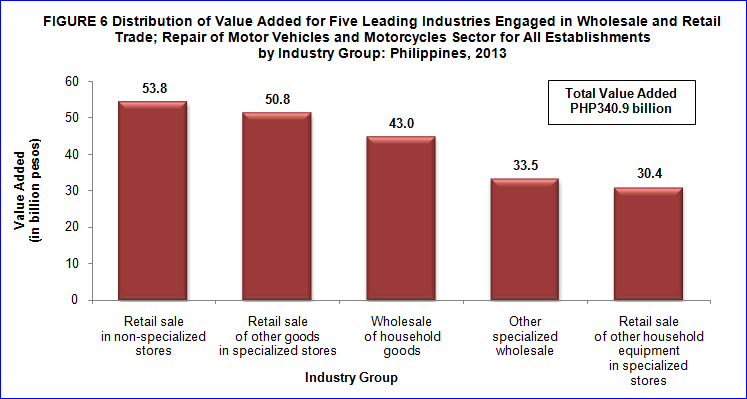
Sale of motor vehicles industry has the highest labor productivity
Value added per employee (a measure the labor productivity of the sector) was estimated at PHP342.6 thousand. Sale of motor vehicles industry recorded the highest among industries, with PHP774.8 thousand while retail sale of food, beverages and tobacco in specialized stores generated the lowest with PHP181.7 thousand.
Gross additions to fixed assets accumulate to PHP20.1 billion
Acquisition of fixed assets by the sector in 2013, summed PHP20.1 billion (capital expenditures less sale of fixed assets). Retail sale in non-specialized stores acquired the biggest gross addition to fixed assets with PHP3.9 billion (19.3%) while retail trade not in stores, stalls or markets had the least with PHP21.4 million.
Total change in inventories amount to PHP61.9 billion
Total change in inventories (ending less beginning inventory) of the sector, amounted to PHP61.5 billion in 2013. Retail sale of other household equipment in specialized stores had the highest value of stocks amounting to PHP10.8 billion (17.6%). Followed by Retail sale of other goods in specialized stores with PHP9.7 billion (15.8%) and Retail sale in non-specialized stores came in third with PHP7.1 billion (11.5%).
Government grants PHP2.2 billion subsidies
Total subsidies received from the government amounted to PHP2.2 billion in 2013.
Wholesale of food, beverages and tobacco industry and Retail sale in non-specialized stores, received subsidies worth PHP2.2 billion.
Sales from E-commerce reach PHP1.8 billion
Sales from e-commerce transactions of the sector reached PHP1.7 billion. Three industries of the sector posted the highest e-commerce transactions namely:
- Retail sale of other household equipment in specialized stores with PHP1.1 billion, (62.0%)
- Wholesale of household goods with PHP488.8 million, (28.0%)
- Wholesale of machinery, equipment and supplies with PHP89.5 million, (5.1%)
TECHNICAL NOTES
Introduction
This Special Release presents the final results of the 2013 Annual Survey of Philippine Business and Industry (ASPBI) for the Wholesale and retail trade; repair of motor vehicles and motorcyles sector for all employment sizes in the formal sector of the economy.
The 2013 ASPBI is one of the designated statistical activities of the former National Statistics Office (NSO) now Philippine Statistics Authority (PSA). Data collected from the survey will provide information on the levels, structure, performance and trends of economic activities of the formal sector of the economy for the reference period 2013. It will also serve as benchmark information in the measurement and comparison of national and regional economic growth.
To provide establishment respondents ease of accomplishing the 2013 ASPBI questionnaires, the income and expense account in the Financial Statement of establishment was adopted in the design of sectoral 2013 ASPBI questionnaires. Income and revenue have the same concept in recording financial transaction of establishments while expense is cost incurred on a consumed basis.
Data collection was intensified through the use of web-based or online accomplishment of questionnaire through the PSA website and downloading of e-questionnaire and submission thru e-mail.
Legal Authority
The conduct of the 2013 ASPBI is authorized under Republic Act 10625 known as the Philippine Statistical Act of 2013 - Reorganizing and strengthening of the Philippine Statistical System (PSS), its agencies and instrumentalities.
- Republic Act 10625 know as the Philippine Statistical Act of 2013 dated September 12, 2013 - (Reorganizing and strengthening of the Philippine Statistical System (PSS), its agencies and instrumentalities). It shall be the policy of the State to effect the necessary and proper changes in the organizational and functional structures of the PSS in order to rationalize and promote efficiency and effectiveness in the delivery of statistical services.
- Section 27 of Republic Act No. 10625 states that:
"... Respondents of primary data collection activities such as censuses and sample surveys are obliged to give truthful and complete answers to statistical inquiries. The gathering, consolidation and analysis of such data shall likewise be done in the most truthful and credible manner. Any violation of this Act shall result in the imposition of the penalty of one (1) yearimprisonment and a fine of One hundred thousand pesos (P100,000.00). In cases where the respondent fails to give truthfulcomplete answers to such statistical inquiries is a corporation, the above penalty shall be imposed against, such corporation, enterprise or business concerned, shall be imposed a fine ranging from One hundred thousand pesos (P100,000.00) to Five hundred thousand pesos (P500,000.00)..."
- Republic Act No. 10625 (Philippine Statistical Act of 2013)
Section 27 of RA 10625 states that:
"... Any person, including parties within the PSA Board and the PSA, who breach the confidentiality of information, whether by carelessness, improper behavior, behavior with malicious intent, and use of confidential information for profit, are considered guilty of an offense and shall be liable to fines as prescribed by the PSA Board which shall not be less than Five thousend pesos (P5,000.00) nor more than Ten thousand pesos (P10,000,00.00) and/or imprisonment of three (3) months but not exceed one (1) year, subject to the degree of breech of information..."
- Republic Act 6713 (Code of Conduct and Ethical Standards for Public Officials and Employees) dated February 20, 1989.
Section 7 of RA 6713 states that:
"... (c) Disclosure and/or misuse of confidential informatiom. Public officials and employees shall not use or divulge confidential or classified information officially known to them by reason of their office and not made available to the public, either: (1) to further their private interest, or give undue advantage of anyone, or (2) to prejudice the public interest..."
Scope and Coverage
The 2013 ASPBI was a nationwide undertaking confined to the formal sector of the economy and as such excluded the informal sector. The following comprise the formal sector:
- Corporations and partnerships
- Cooperatives and foundations
- Single establishment with employment of 10 or more
- Single proprietorship with branches
Hence, the 2013 ASPBI covered only the following economic units:
- All establishments with total employment (TE) of 10 or more, and;
- All establishments with TE of less than 10, except those establishments with Legal Organization = 1 (single proprietorship) and Economic Organization = 1 (single establishment), that are engaged in economic activities classified according to the 2009 Philippine Standard Industrial Classification (PSIC).
The initial estimate of the 2013 LE shows about 941,000 establishments in operation in the country for the year. About 263,000 establishments (28% of total establishments) belong to the "Formal Sector" of which 229,000 (87%) comprise the establishment frame.
Listed below are the 18 economic sectors within the scope of the 2013 ASPBI classified under the 2009 PSIC.
- Agriculture, Forestry and Fishing (A)
- Mining and Quarrying (B)
- Manufacturing (C)
- Electricity, Gas, Steam, and Air Conditioning Supply (D)
- Water Supply; Sewerage, Waste Management and Remediation Activities (E)
- Construction (F)
- Wholesale and Retail Trade; Repair and Maintenance of Motor Vehicles, Motorcycles (G)
- Transportation and Storage (H)
- Accommodation and Food Service Activities (I)
- Information and Communication (J)
- Financial and Insurance Activities (K)
- Real Estate Activities (L)
- Professional, Scientific and Technical Activities (M)
- Administrative and Support Service Activities (N)
- Education (P)
- Human Health and Social Work Activities (Q)
- Arts, Entertainment and Recreation (R)
- Other Service Activities (S)
Sampling Design
Unit of Enumeration
The unit of enumeration for the 2013 ASPBI was the establishment. An establishment is defined as an economic unit, which engages, under a single ownership or control, in one or predominantly one kind of activity at a single fixed physical location.
Classification of Establishments
An establishment is categorized by its economic organization (EO), legal organization (LO), industrial classification, employment size and geographic location.
Economic Organization (EO). This refers to the organizational structure or role of the establishment in the organization. The following are the types of economic organization:
- Single establishment (EO=1) is an establishment which has neither branch nor main office. It may have ancillary unit/s, other than main office, located elsewhere.
- Branch only (EO=2) is an establishment which has a separate main office located elsewhere.
- Establishment and Main Office (EO=3) is one where the establishment is located in the same address as the main office and with branch/es elsewhere.
- Main Office (EO=4) is a unit which controls, supervises and directs one or more establishments of an enterprise.
- Ancillary Unit other than Main Office (EO=5) is a unit that operates primarily or exclusively for a related establishment or group of related establishments or its parent establishment and provides services that support those establishments.
Legal Organization (LO). This refers to the legal form of the economic entity that provides the legal basis for ownership of the establishment. The following are the types of legal organization:
- Single Proprietorship (LO=1) refers to a business establishment organized, owned, and managed by one person, who alone assumes the risk of the business enterprise. A sole proprietorship must apply for a business name and be registered with the Department of Trade and Industry (DTI).
- Partnership (LO=2) refers to an association of two or more individuals for the conduct of a business enterprise based upon an agreement or contract between or among them to contribute money, property or industry into a common fund with the intention of dividing profits among themselves.
- Government Corporation (LO=3) also called Government-Owned or Controlled Corporation (GOCC) refers to a corporation organized for private aim, benefit or purpose with the government as the major stockholder, regardless of whether they are stock or non-stock corporations.
- Stock Corporation (LO=4) refers to an ordinary business corporation organized by private persons, created and operated for the purpose of making a profit which may be distributed in the form of dividends to stockholders on the basis of their invested capital.
- Non Stock, Non-profit Corporation (LO=5) refers to a business corporation which does not issue stock to its members and are created not to profit but for the public good and welfare. Of this character are most of the religious, social, charitable, educational, literary scientific, civic and political organizations and societies.
- Cooperative (LO=6) refers to an organization composed primarily of small producers and/or consumers who voluntarily join together to form a business enterprise which they themselves own, control and patronize.
- Others (LO=7) refer to an organization not classified in any of the above classification. It includes private associations, foundations, Non-Governmental Organizations, or other forms of legal organizations.
Industrial Classification. The Industrial Classification of an economic unit is determined by the activity from which it derives its major income or revenue. The 2009 PSIC which was approved for adoption by government agencies and instrumentalities through NSCB Resolution No. 2 Series 2010 was utilized to classify economic units according to their economic activities.
Size (SZ) of the Unit of Enumeration. The size of an economic unit is determined by its total employment (TE) as of specific date. Total employment (TE) refers to the total number of persons who work in or for the establishment/enterprise. This includes paid employees, working owners, unpaid workers and all employees who work full-time or part-time including seasonal workers. Included also are persons on short term leave such as those on sick, vacation or annual leaves and on strike.
The following are the size codes and corresponding total employment used in the 2013 ASPBI:
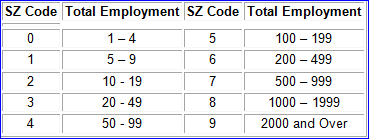
Geographic Classification. Establishments are also classified by geographic area using the Philippine Standard Geographic Code (PSGC) classification. The PSGC contains the latest updates on the official number of regions, provinces, cities, municipalities, and barangays in the Philippines. The latest PSGC as of December 31, 2013 was used for the 2013 ASPBI.
Sampling Design
Selection of sample establishment for the 2013 ASPBI was done using stratified systematic sampling with 3-digit or 5-digit PSIC serving as industry strata and employment size as the second stratification variable.
Estimation Procedure
For Establishments with TE of Less Than 20
a. Non-Certainty Stratum
The estimate of the total of a characteristic  for the non-certainty employment stratum TE less than 20 in the sth industry domain was
for the non-certainty employment stratum TE less than 20 in the sth industry domain was

where:
- s = denotes the non-certainty employment strata in TE of less than 20
- Xsj = value of the jth establishment in non-certainty employment stratum in TE of less than 20 in Sth industry domain
- j = 1,2,3..., ns establishments
- Wsj = weight of the jth establishment in the non-certainty employment stratum of less than 20 in the sth industry domain

- Ns = total number of establishments in the non-certainty employment stratum in TE of less than 20 in the sth industry domain
- ns = number of sample establishments in the non-certainty employment stratum in TE of less than 20 in sth domain
b. Certainty Stratum
The total of a characteristic  for the certainty employment stratum in the Cth industry domain was
for the certainty employment stratum in the Cth industry domain was

where:
- c = denotes the certainty employment strata in TE of less than 20 in the cth industry
- xcj = value of the jth establishment in the certainty employment strata in TE of less than 20 in the cth industry domain
- j = 1,2,3,..., mc establishments
- mc = number of establishments in the certainty employment strata in TE of less than 20 in the cth industry domain
c. Total Estimate for TE of Less Than 20
For all sections except B and C, national level estimates of the total of a characteristic  for the industry domain was obtain by aggregating the estimates for all employment strata (non-certainty and certainty) in the same industry domain,
for the industry domain was obtain by aggregating the estimates for all employment strata (non-certainty and certainty) in the same industry domain,

where d denotes the industry domain.
For Establishments with TE of 20 and Over
a. Non-Certainty Stratum (strata of TE 20 to 49 and TE 50 to 99 for Sections G, H, I, J, K, L, M, N, P, Q, R and S.
The estimate of the total of a characteristic ![]() for the non-certainty employment strata in TE of 20 and over for selected industry domain in each region was
for the non-certainty employment strata in TE of 20 and over for selected industry domain in each region was

where:
- s = denotes the non-certainty employment strata in TE 20 and over
- p = 1,2,...,17 regions geographic domains
- xspj = value of the jth establishment in the certainty employment strata in TE of 20 and over for an industry domain in each region
- j = 1,2,3..., nsp establishments
- Wspj = weight of the jth establishment in the non-certainty employment strata in TE of 20 and over for an industry domain in each region

- Nsp = total number of establishments in the non-certainty employment strata in TE of 20 and over for an industry domain in each region
- nsp = number of sample establishments in the non-certainty employment strata in TE of 20 and over for an industry domain in each region
b. Certainty Stratum
The the total of a characteristic  for the certainty employment stratum in TE of 20 and over in an industry domain in each region was
for the certainty employment stratum in TE of 20 and over in an industry domain in each region was

where:
- c = denotes the non-certainty employment strata in TE of 20 and over
- p = 1,2,...17, regions (geographic domains)
- xcpj = value of the jth establishment in the certainty employment strata in TE of 20 and over in an industry domain within each region
- j = 1,2,3..., mcp establishment
- mcp = number of establishments in the certainty strata in TE of 20 and over in an industry domain in each region
c. Total Estimate for TE of 20 and Over
The estimate of the total of a characteristic  for the industry domain in each (geographic domain) was obtained by aggregating the estimates for all employment strata (non-certainty and certainty) in the same industry domain,
for the industry domain in each (geographic domain) was obtained by aggregating the estimates for all employment strata (non-certainty and certainty) in the same industry domain,

where dp denotes the industry domains in each region.
National level estimates of the characteristics by industry domain were obtained by aggregating separately the estimates (Xdp) for the particular industry domain from all the regions.
Weight Adjustment Factor for Non-Response
To account for non-response in the non-certainty strata, the adjustment factor (n/n’) was multiplied with the sampling weight (W) of each of the sampling unit. The sampling weight, defined as N/n, was recomputed as

Thus, the adjusted weight (W’sj) for employment stratum in TE 1-9 or TE 10-19 was

where:
- Ns = total number of establisments in the employment stratum in TE 1-9 or TE 10-19 in the sth industry domain
- n's = number of responding establishments in the employment stratum in TE 1-9 or TE 10-19 in the sth industry domain
For the non-certainty employment stratum for the selected industry domain with TE 20-99, the adjusted weight (W'spj) was

where:
- Nsp = total number of establisments in the non-certainty employment stratum with TE 20-99 for the selected industry domain within each geographic domain (region)
- n'sp = number of responding establishments in the non-certainty employment stratum with TE 20-99 for the selected industry domain within each geographic domain (region)
Questionaire Design
The questionnaire design is basically the same as that of the 2012 Census of Philippine Business and Industry. However, changes were made in the disaggregation of data items for fixed assets in support to the requirements of the 2008 Systems of National Accounts with respect to the generation of fixed capital formation.
The sample establishments responded also to the survey through the use of Web-based version of the 2013 ASPBI questionnaires which was accomplished online at the PSA website. Likewise, an e-questionnaire was also downloaded and submitted thru e-mail.
Response Rate
Field operations of the 2013 ASPBI were scheduled from September to December 2014.
Total response rate for Wholesale and retail trade; repair of motor vehicles and motorcyles sector was 89.6 percent (5,406 out of 6,032 establishments). These include receipts of "good" questionnaires, partially accomplished questionnaires, reports of closed, moved out or out of scope establishments.
Of the total responses, 77 establishments responded online.
Concepts and Definitions of Terms
Establishment is an economic unit under a single ownership control, i.e., under a single entity, engaged in one or predominantly one kind of economic activity at a single fixed location.
Total Employment is the number of persons who worked in for the establishment as of November 15, 2013.
Paid employees are all full-time and part-time employees working in or for the establishment and receiving pay, as well as those working away from the establishment and paid by and under the control of the establishment. Included also are all employees on sick or maternity leave, paid vacation or holiday and on strike. Excluded are directors paid solely for their attendance at meetings, consultants, workers on indefinite leave, working owners who do not receive regular pay, home workers and workers receiving pure commissions only.
Unpaid workers are working owners who do not receive regular pay, apprentices and learners without regular pay and persons working for at least 1/3 of the working time normal to the establishment without regular pay. Excluded are silent or inactive business partners.
Compensation is the sum of salaries and wages, separation, terminal pay and gratuities paid by the establishment to its employees and total employer’s contribution to SSS/GSIS, ECC, PhilHealth, Pag-ibig, etc.
Salaries and wages are payments in cash or in kind to all employees, prior to deductions for employee’s contributions to SSS/GSIS, withholding tax, etc. Included are total basic pay, overtime pay and other benefits.
Income or Revenue includes cash received and receivables for goods/products and by-products sold and services rendered. Valuation is at producer prices (ex-establishment) net of discounts and allowances, including duties and taxes but excluding subsidies.
Cost refers to all expenses excluding compensation incurred during the year whether paid or payable. Valuation should be at purchaser price including taxes and other charges, net of discounts, rebates, returns and allowances. Goods received from and services rendered by other establishment of the same enterprise are valued as though purchased.
Expense refers to cost incurred by the establishment during the year whether paid or payable. This is treated on a consumed basis. Valuation is at purchaser price including taxes and other charges, net of rebates, returns and allowances. Goods and services received by the establishment from other establishments of the same enterprise are valued as though purchased.
Intermediate cost refers to expenses incurred in the production of goods such as materials and supplies purchased, fuels purchased, electricity purchased and industrial services done by others plus beginning inventory of materials, supplies and fuels less ending inventory of materials, supplies and fuels.
Value Added is gross output less intermediate input. Gross output for Wholesale and retail trade; repair of motor vehicles and motorcycles is the sum of the total revenue (less interest income, rent income from land, dividend income, royalty income and franchise income), capital expenditures of fixed assets produced on own account and change in inventories. Intermediate input is equal to the sum of the following cost items: materials and supplies purchased; fuels, lubricants, oils and greases purchased; electricity purchased, water purchased; cost of industrial services done by others; cost of non-industrial services done by others; goods purchased for resale; research and development expense; environmental protection expense; royalty fee; franchise fee; payouts and other cost.
Gross addition to tangible fixed assets is equal to capital expenditures less sale of fixed assets, including land.
Change in total inventories is computed as the total of ending inventory less the total beginning inventory.
Inventories refer to the stock of goods owned by and under the control of the establishment as of a fixed date, regardless of where the stocks are located. Valuation is at current replacement cost in purchaser prices. Replacement cost is the cost of an item in terms of its present price rather than its original cost.
E-Commerce refers to the selling of products or services over electronic systems such as the Internet Protocol-based networks and other computer networks, Electronic Data Interchange (EDI) network, or other on-line system.
